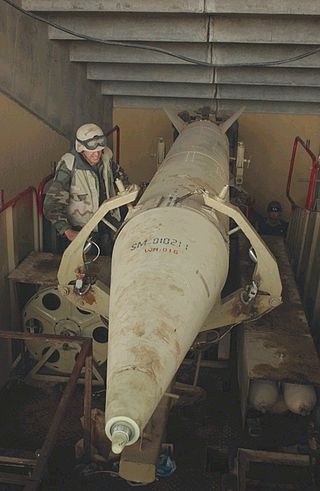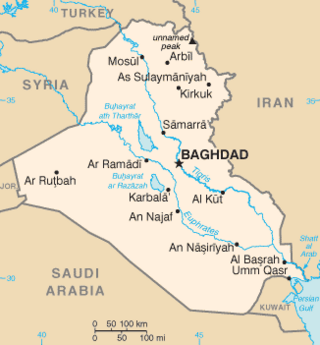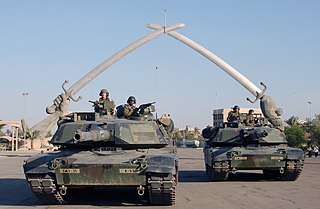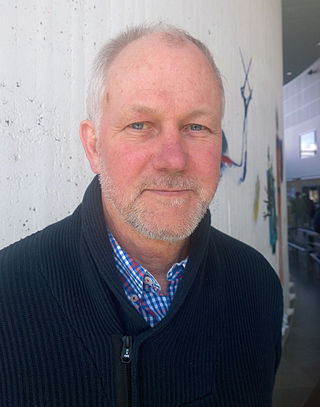
The Iraq disarmament crisis was claimed as one of primary issues that led to the multinational invasion of Iraq on 20 March 2003.

The United Nations Monitoring, Verification and Inspection Commission (UNMOVIC) was created through the adoption of United Nations Security Council resolution 1284 of 17 December 1999 and its mission lasted until June 2007.

United Nations Security Council Resolution 1441 is a United Nations Security Council resolution adopted unanimously by the United Nations Security Council on 8 November 2002, offering Iraq under Saddam Hussein "a final opportunity to comply with its disarmament obligations" that had been set out in several previous resolutions. It provided a justification for the subsequent US invasion of Iraq.

Hans Martin Blix is a Swedish diplomat and politician for the Liberal People's Party. He was Swedish Minister for Foreign Affairs (1978–1979) and later became the head of the International Atomic Energy Agency. As such, Blix was the first Western representative to inspect the consequences of the Chernobyl disaster in the Soviet Union on site, and led the agency response to them. Blix was also the head of the United Nations Monitoring, Verification and Inspection Commission from March 2000 to June 2003, when he was succeeded by Dimitris Perrikos. In 2002, the commission began searching Iraq for weapons of mass destruction, ultimately finding none. On 17 March 2003, U.S. President George W. Bush delivered an address from the White House announcing that within 48 hours, the United States would invade Iraq unless Saddam Hussein would leave. Bush then ordered all of the weapons inspectors, including Blix's team, to leave Iraq so that America and its allies could invade Iraq on 20 March. In February 2010, Blix became head of the United Arab Emirates' advisory board for its nuclear power program. He is the former president of the World Federation of United Nations Associations.

Iraq actively researched and later employed weapons of mass destruction (WMD) from 1962 to 1991, when it destroyed its chemical weapons stockpile and halted its biological and nuclear weapon programs as required by the United Nations Security Council. The fifth president of Iraq, Saddam Hussein, was internationally condemned for his use of chemical weapons against Iranian and Kurdish civilians during the Iran–Iraq War in the 1980s. Saddam pursued an extensive biological weapons program and a nuclear weapons program, though no nuclear bomb was built. After the Gulf War, the United Nations located and destroyed large quantities of Iraqi chemical weapons and related equipment and materials; Iraq ceased its chemical, biological and nuclear programs.
United Nations Special Commission (UNSCOM) was an inspection regime created by the United Nations to ensure Iraq's compliance with policies concerning Iraqi production and use of weapons of mass destruction after the Gulf War. Between 1991 and 1997 its director was Rolf Ekéus; from 1997 to 1999 its director was Richard Butler.

Al-Samoud was a liquid-propellant rocket tactical ballistic missile developed by Iraq in the years between the Gulf War and the 2003 Invasion of Iraq. The Iraqi army also developed a solid-fuel rocket version known as Ababil-100.

David Christopher Kelly was a Welsh scientist and authority on biological warfare (BW). A former head of the Defence Microbiology Division working at Porton Down, Kelly was part of a joint US-UK team that inspected civilian biotechnology facilities in Russia in the early 1990s and concluded they were running a covert and illegal BW programme. He was appointed to the United Nations Special Commission (UNSCOM) in 1991 as one of its chief weapons inspectors in Iraq and led ten of the organisation's missions between May 1991 and December 1998. He also worked with UNSCOM's successor, the United Nations Monitoring, Verification and Inspection Commission (UNMOVIC) and led several of their missions into Iraq. During his time with UNMOVIC he was key in uncovering the anthrax production programme at the Salman Pak facility, and a BW programme run at Al Hakum.
Operation Rockingham was the codeword for UK involvement in inspections in Iraq following the war over Kuwait in 1990–91. Early in 1991 the United Nations Special Commission on Iraq (UNSCOM) was established to oversee the destruction of Iraq's weapons of mass destruction. Use of the codeword was referred to in the annual British defence policy white paper "Statement on the Defence Estimates 1991" where at page 28 it states "The United Kingdom is playing a full part in the work of the Special Commission; our involvement is known as Operation ROCKINGHAM." The activities carried out by the UK as part of Rockingham were detailed in the following white paper.

The Al Qa'qaa' State Establishment was a massive weapons facility 48 kilometres south of Baghdad. It is near to the towns of Yusifiyah and Iskandariya at the geographic coordinates 33°0′54″N44°13′12″E. Covering an area of over 28 km2 (10.8 mi2), the site comprises 116 separate factories and over 1,100 structures of various kinds. It is now disused and many of the buildings have been destroyed by bombing, looting and accidental explosions. In October 2004, the facility became the centre of international attention after a UN agency reported hundreds of tonnes of stored explosives "missing".

The Al Qa'qaa high explosives controversy concerns the possible removal of about 377 tonnes of high explosives from the Al Qa'qaa facility by the Iraqi insurgency, after the 2003 invasion of Iraq. Although Pentagon spokesman Lawrence Di Rita said that the International Atomic Energy Agency (IAEA) has not come forward with documentation that explains how it arrived at the figure of 377 tons of missing explosives. The IAEA so far only has verified in its paperwork that 219 tons of explosive materials were at Al Qaqaa and surrounding facilities.

United Nations Security Council resolution 1284, adopted on 17 December 1999, after recalling previous relevant resolutions on Iraq, including resolutions 661 (1990), 687 (1991), 699 (1991), 707 (1991), 715 (1991), 986 (1995), 1051 (1996), 1153 (1998), 1175 (1998), 1242 (1999) and 1266 (1999), the council established the United Nations Monitoring, Verification and Inspection Commission (UNMOVIC) to replace the United Nations Special Commission (UNSCOM). It was the final resolution adopted in 1999.

There are various rationales for the Iraq War, both the 2003 invasion of Iraq and the subsequent hostilities. The George W. Bush administration began actively pressing for military intervention in Iraq in late 2001. The primary rationalization for the Iraq War was articulated by a joint resolution of the United States Congress known as the Iraq Resolution. The US claimed the intent was to "disarm Iraq of weapons of mass destruction, to end Saddam Hussein's support for terrorism, and to free Iraqi people".

A dispute exists over the legitimacy of the 2003 invasion of Iraq. The debate centers around the question whether the invasion was an unprovoked assault on an independent country that may have breached international law, or if the United Nations Security Council authorized the invasion. Those arguing for its legitimacy often point to Congressional Joint Resolution 114 and UN Security Council resolutions, such as Resolution 1441 and Resolution 678. Those arguing against its legitimacy also cite some of the same sources, stating they do not actually permit war but instead lay out conditions that must be met before war can be declared. Furthermore, the Security Council may only authorise the use of force against an "aggressor" in the interests of preserving peace, whereas the 2003 invasion of Iraq was not provoked by any aggressive military action.
Alexander Coker was formerly a Chief Inspector of the Chemical Weapons team in Iraq, while working for the United Nation’s Monitoring, Verification and Inspection Commission (UNMOVIC). Prior to that he held various other posts at UNMOVIC and had been seconded from the British Government to carry out work for UNMOVIC’s predecessor, the United Nations Special Commission (UNSCOM).
Corinne Heraud was formerly a Chief Inspector of the Missile inspection team in Iraq, while working for the United Nation's Monitoring, Verification and Inspection Commission (UNMOVIC). Prior to that she held various other posts at UNMOVIC and had been seconded from the French Government to carry out work for UNMOVIC's predecessor, the United Nations Special Commission (UNSCOM).

United Nations Security Council resolution 1194, adopted unanimously on 9 September 1998, after reaffirming resolutions 687 (1991), 707 (1991), 715 (1991), 1060 (1996), 1115 (1997) and 1154 (1998) concerning Iraq's weapons programme, the council condemned Iraq's decision to suspend co-operation with the United Nations Special Commission (UNSCOM) and the International Atomic Energy Agency (IAEA).
Rihab Rashid Taha al-Azawi is an Iraqi microbiologist, dubbed Dr Germ by United Nations weapons inspectors, who worked in Saddam Hussein's biological weapons program. A 1999 report commissioned by the United States Joint Chiefs of Staff and the Defense Intelligence Agency (DIA) named her as one of the world's most dangerous women. Dr Taha admitted producing germ warfare agents but said they had been destroyed.

Åke Sellström is a Swedish academic and expert in arms, especially in chemical weapons. He has been active at the Swedish Defence Research Agency (FOI).











